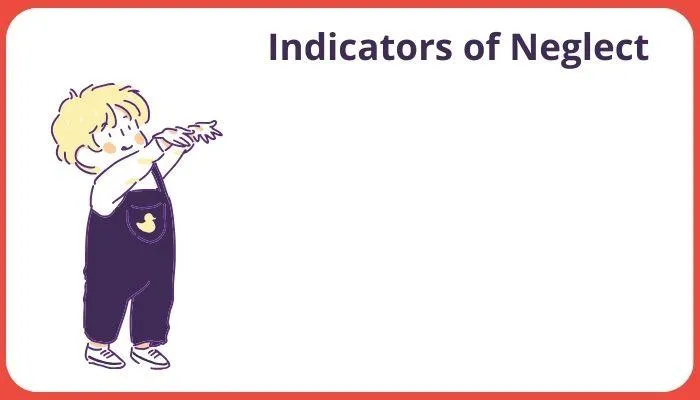Every child's well-being matters.
Types of Abuse Articles
Quick Access
Abuse of Authority
Abuse of Discretion
Abuse of Power
Behavioural Indications
Breast Ironing
County Lines
Cultural Differences (Physical Abuse)
Domestic Abuse
Economic Abuse
Emotional Signs
Exposure to Substance Abuse
Failure to Thrive
Female Genital Mutilation (FGM)
Forced Marriage
Hate Crimes & Targeted Harassment
Impact of Domestic Violence
Impact of Environment
Impact on Development
Institutional Abuse
Isolation
Modern Slavery
Neglect
Online Abuse
Parental Behaviours
Physical Abuse
Radicalisation
Religious Abuse
Restraint
Sexual Abuse
Types of Abuse
Witnessing Domestic Abuse

What are the indicators for neglect when considering safeguarding?
Neglect is a form of abuse that occurs when a child's basic needs for care are not met.
Neglect can manifest in various ways, and recognising the indicators is crucial for safeguarding individuals.
Here are some signs to look for when considering Neglect:
Physical Signs:
Persistent poor hygiene and unkempt appearance.
Inadequate clothing for weather conditions.
Untreated medical or dental issues.
Health and Development:
Consistent hunger or malnutrition.
Lack of appropriate medical care and missed appointments.
Delayed physical or emotional development.
Education:
Chronic absenteeism without a valid explanation.
Lack of necessary educational materials or appropriate learning environment.
Unaddressed learning disabilities or developmental delays.
Safety and Supervision:
Leaving a child unattended for inappropriate periods.
Inadequate supervision, especially in hazardous environments.
Frequent exposure to unsafe conditions without intervention.
Emotional Well-being:
Persistent feelings of loneliness or isolation.
Lack of emotional responsiveness from caregivers.
Low self-esteem and challenges forming social connections.
Basic Needs:
Insufficient access to nutritious food.
Inadequate shelter, including unsafe living conditions.
Lack of appropriate clothing, especially during extreme weather.
Parental Behaviour:
Substance abuse or addiction issues affecting caregiving abilities.
Mental health challenges hinder the ability to provide proper care.
Disinterest or indifference towards the child's well-being.
Financial Stability:
Ongoing struggles to meet basic needs due to financial difficulties.
Limited access to essential resources despite available assistance programs.
Inability to provide necessary medical care or educational support.
Social Isolation:
Limited social interactions for the child, with few or no friends.
Minimal engagement with community or support networks.
Lack of involvement in age-appropriate activities.
AUTHOR:- Iona has nearly 10 years of experience supporting nurseries and childminders in curriculum planning, leadership, and safeguarding. Her writing is informed by public information and sector insight, aiming to provide accessible, practical support for professionals working with children. She is part of the On the Button team, helping deliver Well-being, Safeguarding and Complaint Management Software that empowers practitioners to identify concerns early and act confidently.
On the Button provides innovative software tailored to the needs of the early years sector, with a strong focus on EYFS well-being and early years safeguarding. Our tools help senior practitioners to confidently track concerns, maintain robust records, and respond effectively — all while meeting statutory guidance. From early years complaint management to team-wide safeguarding alerts, our platform puts children's safety and emotional health first.
Quick Access
Abuse of Authority
Abuse of Discretion
Abuse of Power
Behavioural Indications
Breast Ironing
County Lines
Cultural Differences (Physical Abuse)
Domestic Abuse
Economic Abuse
Emotional Signs
Exposure to Substance Abuse
Failure to Thrive
Female Genital Mutilation (FGM)
Forced Marriage
Hate Crimes & Targeted Harassment
Impact of Domestic Violence
Impact of Environment
Impact on Development
Institutional Abuse
Isolation
Modern Slavery
Neglect
Online Abuse
Parental Behaviours
Physical Abuse
Radicalisation
Religious Abuse
Restraint
Sexual Abuse
Types of Abuse
Witnessing Domestic Abuse

What are the indicators for neglect when considering safeguarding?
Neglect is a form of abuse that occurs when a child's basic needs for care are not met.
Neglect can manifest in various ways, and recognising the indicators is crucial for safeguarding individuals.
Here are some signs to look for when considering Neglect:
Physical Signs:
Persistent poor hygiene and unkempt appearance.
Inadequate clothing for weather conditions.
Untreated medical or dental issues.
Health and Development:
Consistent hunger or malnutrition.
Lack of appropriate medical care and missed appointments.
Delayed physical or emotional development.
Education:
Chronic absenteeism without a valid explanation.
Lack of necessary educational materials or appropriate learning environment.
Unaddressed learning disabilities or developmental delays.
Safety and Supervision:
Leaving a child unattended for inappropriate periods.
Inadequate supervision, especially in hazardous environments.
Frequent exposure to unsafe conditions without intervention.
Emotional Well-being:
Persistent feelings of loneliness or isolation.
Lack of emotional responsiveness from caregivers.
Low self-esteem and challenges forming social connections.
Basic Needs:
Insufficient access to nutritious food.
Inadequate shelter, including unsafe living conditions.
Lack of appropriate clothing, especially during extreme weather.
Parental Behaviour:
Substance abuse or addiction issues affecting caregiving abilities.
Mental health challenges hinder the ability to provide proper care.
Disinterest or indifference towards the child's well-being.
Financial Stability:
Ongoing struggles to meet basic needs due to financial difficulties.
Limited access to essential resources despite available assistance programs.
Inability to provide necessary medical care or educational support.
Social Isolation:
Limited social interactions for the child, with few or no friends.
Minimal engagement with community or support networks.
Lack of involvement in age-appropriate activities.
AUTHOR:- Iona has nearly 10 years of experience supporting nurseries and childminders in curriculum planning, leadership, and safeguarding. Her writing is informed by public information and sector insight, aiming to provide accessible, practical support for professionals working with children. She is part of the On the Button team, helping deliver Well-being, Safeguarding and Complaint Management Software that empowers practitioners to identify concerns early and act confidently.
On the Button provides innovative software tailored to the needs of the early years sector, with a strong focus on EYFS well-being and early years safeguarding. Our tools help senior practitioners to confidently track concerns, maintain robust records, and respond effectively — all while meeting statutory guidance. From early years complaint management to team-wide safeguarding alerts, our platform puts children's safety and emotional health first.

What are the indicators for neglect when considering safeguarding?
Neglect is a form of abuse that occurs when a child's basic needs for care are not met.
Neglect can manifest in various ways, and recognising the indicators is crucial for safeguarding individuals.
Here are some signs to look for when considering Neglect:
Physical Signs:
Persistent poor hygiene and unkempt appearance.
Inadequate clothing for weather conditions.
Untreated medical or dental issues.
Health and Development:
Consistent hunger or malnutrition.
Lack of appropriate medical care and missed appointments.
Delayed physical or emotional development.
Education:
Chronic absenteeism without a valid explanation.
Lack of necessary educational materials or appropriate learning environment.
Unaddressed learning disabilities or developmental delays.
Safety and Supervision:
Leaving a child unattended for inappropriate periods.
Inadequate supervision, especially in hazardous environments.
Frequent exposure to unsafe conditions without intervention.
Emotional Well-being:
Persistent feelings of loneliness or isolation.
Lack of emotional responsiveness from caregivers.
Low self-esteem and challenges forming social connections.
Basic Needs:
Insufficient access to nutritious food.
Inadequate shelter, including unsafe living conditions.
Lack of appropriate clothing, especially during extreme weather.
Parental Behaviour:
Substance abuse or addiction issues affecting caregiving abilities.
Mental health challenges hinder the ability to provide proper care.
Disinterest or indifference towards the child's well-being.
Financial Stability:
Ongoing struggles to meet basic needs due to financial difficulties.
Limited access to essential resources despite available assistance programs.
Inability to provide necessary medical care or educational support.
Social Isolation:
Limited social interactions for the child, with few or no friends.
Minimal engagement with community or support networks.
Lack of involvement in age-appropriate activities.
AUTHOR:- Iona has nearly 10 years of experience supporting nurseries and childminders in curriculum planning, leadership, and safeguarding. Her writing is informed by public information and sector insight, aiming to provide accessible, practical support for professionals working with children. She is part of the On the Button team, helping deliver Well-being, Safeguarding and Complaint Management Software that empowers practitioners to identify concerns early and act confidently.
On the Button provides innovative software tailored to the needs of the early years sector, with a strong focus on EYFS well-being and early years safeguarding. Our tools help senior practitioners to confidently track concerns, maintain robust records, and respond effectively — all while meeting statutory guidance. From early years complaint management to team-wide safeguarding alerts, our platform puts children's safety and emotional health first.
Quality Early Years Ltd.,
Dickens House,
Guithavon Street,
Witham, Essex,
England, CM8 1BJ
© Quality Early Years Ltd 2025
On the Button are Finalists for 3/3 Early Years Awards!
Find On the Button
on Social Media

